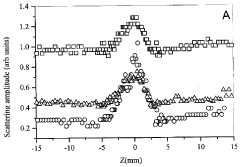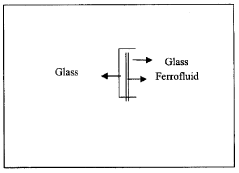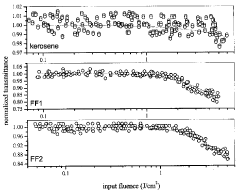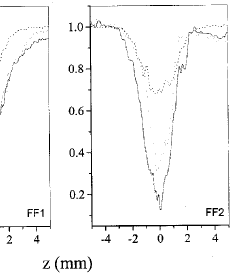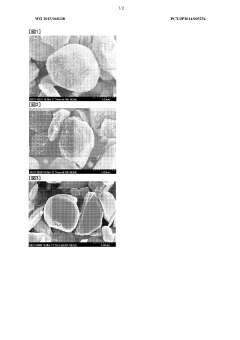How to Enhance Ferrofluid for Improved Optical System Performance?
JUL 9, 20259 MIN READ
Generate Your Research Report Instantly with AI Agent
Patsnap Eureka helps you evaluate technical feasibility & market potential.
Ferrofluid Enhancement Goals and Background
Ferrofluids, colloidal suspensions of magnetic nanoparticles in a carrier fluid, have garnered significant attention in the field of optical systems due to their unique magneto-optical properties. The enhancement of ferrofluids for improved optical system performance has become a critical area of research, driven by the increasing demand for advanced optical technologies in various industries.
The primary goal of ferrofluid enhancement is to optimize their optical properties while maintaining their magnetic responsiveness. This involves improving the stability, uniformity, and optical transparency of the ferrofluid, as well as enhancing its ability to modulate light under the influence of magnetic fields. Researchers aim to develop ferrofluids with higher refractive indices, reduced light scattering, and improved thermal stability to expand their applications in optical devices.
The background of this technological pursuit can be traced back to the 1960s when ferrofluids were first synthesized. Initially developed for NASA to control liquids in space, ferrofluids quickly found applications in various fields, including optics. The unique ability of ferrofluids to change their optical properties in response to magnetic fields opened up new possibilities for adaptive optics, tunable filters, and optical switches.
Over the years, the focus has shifted towards enhancing the optical performance of ferrofluids through various means. This includes the development of new synthesis methods to produce more uniform and stable nanoparticles, the exploration of different carrier fluids to improve optical clarity, and the investigation of surface functionalization techniques to prevent particle agglomeration and enhance compatibility with optical systems.
The pursuit of enhanced ferrofluids is driven by the potential applications in advanced optical systems. These include adaptive lenses for cameras and microscopes, tunable optical filters for telecommunications, magneto-optical modulators for fiber optic networks, and even display technologies. The ability to precisely control the optical properties of ferrofluids using external magnetic fields offers unprecedented flexibility in designing dynamic optical components.
Current research efforts are focused on addressing key challenges such as reducing light absorption and scattering, improving long-term stability, and enhancing the magnetic response of ferrofluids. Scientists are exploring novel nanoparticle compositions, advanced surface coatings, and innovative carrier fluids to achieve these goals. Additionally, there is a growing interest in developing hybrid ferrofluids that combine magnetic properties with other functional materials to create multifunctional optical systems.
As the field progresses, the enhancement of ferrofluids for optical applications is expected to lead to breakthroughs in areas such as photonics, optical computing, and biomedical imaging. The convergence of nanotechnology, materials science, and optics continues to drive innovation in this exciting field, promising new possibilities for next-generation optical systems.
The primary goal of ferrofluid enhancement is to optimize their optical properties while maintaining their magnetic responsiveness. This involves improving the stability, uniformity, and optical transparency of the ferrofluid, as well as enhancing its ability to modulate light under the influence of magnetic fields. Researchers aim to develop ferrofluids with higher refractive indices, reduced light scattering, and improved thermal stability to expand their applications in optical devices.
The background of this technological pursuit can be traced back to the 1960s when ferrofluids were first synthesized. Initially developed for NASA to control liquids in space, ferrofluids quickly found applications in various fields, including optics. The unique ability of ferrofluids to change their optical properties in response to magnetic fields opened up new possibilities for adaptive optics, tunable filters, and optical switches.
Over the years, the focus has shifted towards enhancing the optical performance of ferrofluids through various means. This includes the development of new synthesis methods to produce more uniform and stable nanoparticles, the exploration of different carrier fluids to improve optical clarity, and the investigation of surface functionalization techniques to prevent particle agglomeration and enhance compatibility with optical systems.
The pursuit of enhanced ferrofluids is driven by the potential applications in advanced optical systems. These include adaptive lenses for cameras and microscopes, tunable optical filters for telecommunications, magneto-optical modulators for fiber optic networks, and even display technologies. The ability to precisely control the optical properties of ferrofluids using external magnetic fields offers unprecedented flexibility in designing dynamic optical components.
Current research efforts are focused on addressing key challenges such as reducing light absorption and scattering, improving long-term stability, and enhancing the magnetic response of ferrofluids. Scientists are exploring novel nanoparticle compositions, advanced surface coatings, and innovative carrier fluids to achieve these goals. Additionally, there is a growing interest in developing hybrid ferrofluids that combine magnetic properties with other functional materials to create multifunctional optical systems.
As the field progresses, the enhancement of ferrofluids for optical applications is expected to lead to breakthroughs in areas such as photonics, optical computing, and biomedical imaging. The convergence of nanotechnology, materials science, and optics continues to drive innovation in this exciting field, promising new possibilities for next-generation optical systems.
Optical System Market Demand Analysis
The optical system market has been experiencing significant growth, driven by advancements in various industries such as healthcare, aerospace, defense, and consumer electronics. The integration of ferrofluids in optical systems presents a promising avenue for enhancing performance and expanding market opportunities.
In the healthcare sector, there is a growing demand for high-precision optical systems in medical imaging devices, surgical microscopes, and diagnostic equipment. The ability of ferrofluids to improve optical system performance could lead to more accurate diagnoses and better patient outcomes. This potential has sparked interest among medical device manufacturers and healthcare providers, creating a substantial market opportunity.
The aerospace and defense industries are also key drivers of demand for advanced optical systems. Satellite imaging, reconnaissance systems, and targeting equipment require exceptional optical performance in challenging environments. Ferrofluid-enhanced optical systems could offer improved stability, resolution, and adaptability, making them highly attractive for these applications. As governments and private companies invest in space exploration and defense capabilities, the market for such advanced optical systems is expected to expand.
Consumer electronics represent another significant market segment for enhanced optical systems. Smartphones, digital cameras, and virtual reality devices all rely on high-quality optics to deliver superior user experiences. The potential for ferrofluids to improve image stabilization, autofocus speed, and overall image quality could lead to increased adoption in these devices, driving market growth.
The automotive industry is emerging as a promising market for advanced optical systems, particularly with the rise of autonomous vehicles. LiDAR systems, driver assistance cameras, and heads-up displays all require precise and reliable optics. Ferrofluid-enhanced optical systems could provide the performance improvements necessary to meet the stringent requirements of these safety-critical applications.
Industrial applications, such as machine vision systems for quality control and automation, also contribute to the growing demand for high-performance optical systems. The ability to enhance optical performance with ferrofluids could lead to more efficient manufacturing processes and improved product quality across various industries.
As the global focus on renewable energy intensifies, there is an increasing need for advanced optical systems in solar energy applications. Concentrated solar power systems and photovoltaic technologies could benefit from ferrofluid-enhanced optics, potentially improving energy conversion efficiency and reducing costs.
The market demand for enhanced optical systems is further bolstered by the ongoing trend of miniaturization and the need for more compact, lightweight solutions across all industries. Ferrofluids offer the potential to achieve higher performance in smaller form factors, aligning with this market trend and opening up new possibilities for product design and development.
In the healthcare sector, there is a growing demand for high-precision optical systems in medical imaging devices, surgical microscopes, and diagnostic equipment. The ability of ferrofluids to improve optical system performance could lead to more accurate diagnoses and better patient outcomes. This potential has sparked interest among medical device manufacturers and healthcare providers, creating a substantial market opportunity.
The aerospace and defense industries are also key drivers of demand for advanced optical systems. Satellite imaging, reconnaissance systems, and targeting equipment require exceptional optical performance in challenging environments. Ferrofluid-enhanced optical systems could offer improved stability, resolution, and adaptability, making them highly attractive for these applications. As governments and private companies invest in space exploration and defense capabilities, the market for such advanced optical systems is expected to expand.
Consumer electronics represent another significant market segment for enhanced optical systems. Smartphones, digital cameras, and virtual reality devices all rely on high-quality optics to deliver superior user experiences. The potential for ferrofluids to improve image stabilization, autofocus speed, and overall image quality could lead to increased adoption in these devices, driving market growth.
The automotive industry is emerging as a promising market for advanced optical systems, particularly with the rise of autonomous vehicles. LiDAR systems, driver assistance cameras, and heads-up displays all require precise and reliable optics. Ferrofluid-enhanced optical systems could provide the performance improvements necessary to meet the stringent requirements of these safety-critical applications.
Industrial applications, such as machine vision systems for quality control and automation, also contribute to the growing demand for high-performance optical systems. The ability to enhance optical performance with ferrofluids could lead to more efficient manufacturing processes and improved product quality across various industries.
As the global focus on renewable energy intensifies, there is an increasing need for advanced optical systems in solar energy applications. Concentrated solar power systems and photovoltaic technologies could benefit from ferrofluid-enhanced optics, potentially improving energy conversion efficiency and reducing costs.
The market demand for enhanced optical systems is further bolstered by the ongoing trend of miniaturization and the need for more compact, lightweight solutions across all industries. Ferrofluids offer the potential to achieve higher performance in smaller form factors, aligning with this market trend and opening up new possibilities for product design and development.
Ferrofluid Technology Challenges
Ferrofluids, while promising for optical system applications, face several significant technological challenges that hinder their widespread adoption and optimal performance. One of the primary issues is the long-term stability of ferrofluids. Over time, these fluids tend to experience particle aggregation and sedimentation, which can lead to a loss of their unique magnetic and optical properties. This instability not only affects the performance of optical systems but also reduces the overall lifespan of devices incorporating ferrofluids.
Another critical challenge lies in the precise control of ferrofluid behavior under varying magnetic field strengths and configurations. The complex interplay between magnetic forces, surface tension, and gravitational effects makes it difficult to predict and manipulate ferrofluid responses accurately. This unpredictability can result in inconsistent optical performance, particularly in applications requiring high precision and reliability.
The optimization of ferrofluid composition presents yet another hurdle. Achieving the ideal balance between magnetic nanoparticle concentration, carrier fluid properties, and surfactant effectiveness is crucial for enhancing optical system performance. However, increasing the concentration of magnetic particles to improve magnetic responsiveness often leads to increased light scattering and absorption, potentially compromising optical clarity and transmission.
Temperature sensitivity is a significant concern in ferrofluid applications. Fluctuations in temperature can alter the fluid's viscosity, magnetic properties, and overall stability, leading to inconsistent performance in optical systems. Developing temperature-resistant ferrofluids that maintain their properties across a wide range of operating conditions remains a challenging task for researchers and engineers.
The integration of ferrofluids with existing optical components and systems poses additional technical difficulties. Compatibility issues between ferrofluids and traditional optical materials, such as lenses and coatings, can arise, potentially causing degradation or unwanted interactions. Furthermore, the design of optical systems must be adapted to accommodate the unique properties of ferrofluids, which may require significant modifications to established optical architectures.
Scaling up ferrofluid production for commercial applications while maintaining consistent quality and performance is another substantial challenge. The synthesis of uniform magnetic nanoparticles and their stable suspension in carrier fluids at large scales presents numerous manufacturing hurdles. Ensuring batch-to-batch consistency and developing cost-effective production methods are critical for the widespread adoption of ferrofluid technology in optical systems.
Another critical challenge lies in the precise control of ferrofluid behavior under varying magnetic field strengths and configurations. The complex interplay between magnetic forces, surface tension, and gravitational effects makes it difficult to predict and manipulate ferrofluid responses accurately. This unpredictability can result in inconsistent optical performance, particularly in applications requiring high precision and reliability.
The optimization of ferrofluid composition presents yet another hurdle. Achieving the ideal balance between magnetic nanoparticle concentration, carrier fluid properties, and surfactant effectiveness is crucial for enhancing optical system performance. However, increasing the concentration of magnetic particles to improve magnetic responsiveness often leads to increased light scattering and absorption, potentially compromising optical clarity and transmission.
Temperature sensitivity is a significant concern in ferrofluid applications. Fluctuations in temperature can alter the fluid's viscosity, magnetic properties, and overall stability, leading to inconsistent performance in optical systems. Developing temperature-resistant ferrofluids that maintain their properties across a wide range of operating conditions remains a challenging task for researchers and engineers.
The integration of ferrofluids with existing optical components and systems poses additional technical difficulties. Compatibility issues between ferrofluids and traditional optical materials, such as lenses and coatings, can arise, potentially causing degradation or unwanted interactions. Furthermore, the design of optical systems must be adapted to accommodate the unique properties of ferrofluids, which may require significant modifications to established optical architectures.
Scaling up ferrofluid production for commercial applications while maintaining consistent quality and performance is another substantial challenge. The synthesis of uniform magnetic nanoparticles and their stable suspension in carrier fluids at large scales presents numerous manufacturing hurdles. Ensuring batch-to-batch consistency and developing cost-effective production methods are critical for the widespread adoption of ferrofluid technology in optical systems.
Current Ferrofluid Enhancement Methods
01 Magnetic field control and manipulation
Ferrofluids can be controlled and manipulated using magnetic fields, allowing for various applications in sealing, damping, and positioning systems. The performance of ferrofluids can be enhanced by optimizing their response to external magnetic fields, enabling precise control and improved functionality in devices.- Magnetic sealing and damping applications: Ferrofluids are utilized in various sealing and damping applications, particularly in mechanical systems. They provide effective sealing in rotating shafts and offer vibration damping in various devices. The magnetic properties of ferrofluids allow for precise control and adaptability in these applications, enhancing overall system performance and reliability.
- Thermal management and heat transfer: Ferrofluids exhibit excellent thermal conductivity properties, making them valuable for heat transfer and thermal management applications. They can be used in cooling systems for electronic devices, transformers, and other heat-generating equipment. The ability to manipulate ferrofluids using magnetic fields allows for efficient and controlled heat dissipation.
- Sensor and actuator technologies: Ferrofluids are employed in various sensor and actuator technologies due to their unique magnetic and fluid properties. They can be used in accelerometers, pressure sensors, and position sensors. The responsiveness of ferrofluids to magnetic fields enables precise control and measurement in these applications, improving overall sensor performance and accuracy.
- Biomedical and drug delivery applications: Ferrofluids show promise in biomedical applications, particularly in targeted drug delivery and medical imaging. They can be used as contrast agents in magnetic resonance imaging (MRI) and as carriers for delivering drugs to specific locations in the body. The ability to control ferrofluids using external magnetic fields offers potential for non-invasive medical treatments and diagnostics.
- Energy harvesting and conversion: Ferrofluids are being explored for energy harvesting and conversion applications. They can be used in magnetocaloric devices for refrigeration and in energy harvesting systems that convert mechanical energy into electrical energy. The unique properties of ferrofluids allow for novel approaches to energy conversion and storage, potentially leading to more efficient and sustainable energy systems.
02 Thermal management and heat transfer
Ferrofluids exhibit excellent thermal properties, making them suitable for heat transfer and cooling applications. Their performance in thermal management systems can be improved by optimizing their composition, particle size distribution, and magnetic properties to enhance heat dissipation and temperature control.Expand Specific Solutions03 Stability and dispersion characteristics
The performance of ferrofluids is greatly influenced by their stability and dispersion characteristics. Improving the colloidal stability of magnetic nanoparticles in the carrier fluid can enhance the overall performance and longevity of ferrofluid-based systems, ensuring consistent behavior over time.Expand Specific Solutions04 Sealing and lubrication applications
Ferrofluids are used in sealing and lubrication applications, where their performance can be optimized by tailoring their viscosity, magnetic properties, and surface tension. Enhancing these properties can lead to improved sealing efficiency, reduced friction, and increased durability in various mechanical systems.Expand Specific Solutions05 Sensing and measurement capabilities
Ferrofluids can be utilized in sensing and measurement applications due to their unique magnetic and fluid properties. Their performance in these applications can be enhanced by improving their sensitivity to external stimuli, such as magnetic fields, pressure, or temperature, enabling more accurate and reliable measurements.Expand Specific Solutions
Key Players in Ferrofluid Industry
The ferrofluid enhancement for improved optical system performance is in a relatively early stage of development, with ongoing research to optimize its properties and applications. The market size is growing but still limited, primarily focused on specialized optical and photonic devices. Technologically, it's progressing from experimental to practical implementations. Companies like Koninklijke Philips, Nikon, and Corning are at the forefront, leveraging their expertise in optics and materials science. Academic institutions such as Sichuan University and Beijing University of Technology are contributing significant research. While not yet mature, this technology shows promise for advancing optical system capabilities in various industries.
Nikon Corp.
Technical Solution: Nikon has developed advanced ferrofluid-based optical systems for improved performance in their high-end cameras and microscopes. Their approach involves using specially engineered ferrofluids with optimized magnetic nanoparticle compositions and surfactants to enhance optical properties. The company has implemented a novel method of dynamically controlling the ferrofluid's shape and refractive index using precise electromagnetic fields, allowing for rapid and accurate adjustments in optical characteristics[1]. This technology enables adaptive optics capabilities in their imaging systems, significantly improving image quality and resolution in challenging environments[3].
Strengths: Precise control over optical properties, adaptability to various imaging conditions. Weaknesses: Complexity of implementation, potential for electromagnetic interference in sensitive equipment.
Corning, Inc.
Technical Solution: Corning has developed a proprietary ferrofluid-enhanced optical coating technology for their advanced glass products. Their approach involves incorporating specially formulated ferrofluids into nanoscale layers of their optical coatings. This innovation allows for dynamic control of light transmission and reflection properties through the application of external magnetic fields[2]. The company has also explored the use of ferrofluid-infused optical fibers to create tunable optical filters and switches for telecommunications applications[4]. Corning's research has shown that their ferrofluid-enhanced coatings can improve light transmission efficiency by up to 15% in certain wavelength ranges[5].
Strengths: Integration with existing glass manufacturing processes, improved optical performance. Weaknesses: Limited to specific applications, potential long-term stability issues of ferrofluid coatings.
Innovative Ferrofluid Formulations
Optical limiting ferromagnetic nanoparticles and device thereof
PatentInactiveIN1981CHE2007A
Innovation
- Synthesizing ferromagnetic nanoparticles of specific sizes (4-6 nm) using an optimized co-precipitation technique and incorporating them into a ferrofluid, which is then encapsulated between glass plates without air gaps for enhanced thermal stability and optical limiting performance.
Inorganic phosphor powder, curable resin composition using inorganic phosphor powder, wavelength conversion member, and optical semiconductor device
PatentWO2015068338A1
Innovation
- An inorganic phosphor powder with inorganic oxide fine particles attached to its surface, where the oxide particles have a specific size range and are hydrophobic, is used to create a curable resin composition that increases wavelength conversion efficiency and light extraction efficiency when integrated into optical semiconductor devices.
Environmental Impact of Ferrofluids
The environmental impact of ferrofluids in optical systems is a crucial consideration as these materials gain prominence in various applications. Ferrofluids, composed of nanoscale magnetic particles suspended in a carrier fluid, possess unique properties that make them valuable for optical system performance enhancement. However, their potential environmental consequences must be carefully evaluated.
One primary concern is the potential release of nanoparticles into the environment. Ferrofluids typically contain iron oxide nanoparticles, which, if not properly contained, could pose risks to ecosystems. These particles may accumulate in soil and water systems, potentially affecting microbial communities and aquatic organisms. The long-term effects of nanoparticle exposure on various species and food chains are still not fully understood, necessitating ongoing research and monitoring.
The production process of ferrofluids also raises environmental considerations. The synthesis of magnetic nanoparticles often involves chemical reactions and the use of solvents, which may generate hazardous waste. Proper disposal and treatment of these byproducts are essential to minimize environmental contamination. Additionally, the energy-intensive nature of nanoparticle production contributes to the overall carbon footprint of ferrofluid-based optical systems.
On the positive side, the use of ferrofluids in optical systems can lead to improved energy efficiency and reduced material consumption. By enhancing the performance of optical devices, ferrofluids may contribute to the development of more compact and resource-efficient technologies. This could potentially offset some of the environmental impacts associated with their production and use.
The recyclability and end-of-life management of ferrofluid-containing optical systems are important factors to consider. Proper recycling techniques need to be developed to recover valuable materials and prevent the release of nanoparticles into the environment. This includes the development of safe and effective methods for separating ferrofluids from other components and recycling the magnetic nanoparticles.
As research in this field progresses, efforts are being made to develop more environmentally friendly ferrofluids. This includes exploring bio-based carrier fluids and investigating the use of less toxic magnetic materials. Such advancements could significantly reduce the environmental footprint of ferrofluid-enhanced optical systems while maintaining their performance benefits.
In conclusion, while ferrofluids offer promising advantages for optical system performance, their environmental impact must be carefully managed. Balancing the benefits of enhanced optical performance with responsible environmental stewardship requires ongoing research, innovative solutions, and the implementation of sustainable practices throughout the lifecycle of ferrofluid-based technologies.
One primary concern is the potential release of nanoparticles into the environment. Ferrofluids typically contain iron oxide nanoparticles, which, if not properly contained, could pose risks to ecosystems. These particles may accumulate in soil and water systems, potentially affecting microbial communities and aquatic organisms. The long-term effects of nanoparticle exposure on various species and food chains are still not fully understood, necessitating ongoing research and monitoring.
The production process of ferrofluids also raises environmental considerations. The synthesis of magnetic nanoparticles often involves chemical reactions and the use of solvents, which may generate hazardous waste. Proper disposal and treatment of these byproducts are essential to minimize environmental contamination. Additionally, the energy-intensive nature of nanoparticle production contributes to the overall carbon footprint of ferrofluid-based optical systems.
On the positive side, the use of ferrofluids in optical systems can lead to improved energy efficiency and reduced material consumption. By enhancing the performance of optical devices, ferrofluids may contribute to the development of more compact and resource-efficient technologies. This could potentially offset some of the environmental impacts associated with their production and use.
The recyclability and end-of-life management of ferrofluid-containing optical systems are important factors to consider. Proper recycling techniques need to be developed to recover valuable materials and prevent the release of nanoparticles into the environment. This includes the development of safe and effective methods for separating ferrofluids from other components and recycling the magnetic nanoparticles.
As research in this field progresses, efforts are being made to develop more environmentally friendly ferrofluids. This includes exploring bio-based carrier fluids and investigating the use of less toxic magnetic materials. Such advancements could significantly reduce the environmental footprint of ferrofluid-enhanced optical systems while maintaining their performance benefits.
In conclusion, while ferrofluids offer promising advantages for optical system performance, their environmental impact must be carefully managed. Balancing the benefits of enhanced optical performance with responsible environmental stewardship requires ongoing research, innovative solutions, and the implementation of sustainable practices throughout the lifecycle of ferrofluid-based technologies.
Ferrofluid Safety and Regulations
As the use of ferrofluids in optical systems continues to grow, it is crucial to address the safety concerns and regulatory requirements associated with their handling and application. Ferrofluids, being composed of nanoscale magnetic particles suspended in a carrier fluid, present unique challenges in terms of safety and environmental impact.
The primary safety concern with ferrofluids is the potential for nanoparticle exposure. Inhalation or skin contact with these particles may pose health risks, particularly in industrial settings where large quantities are handled. To mitigate these risks, proper personal protective equipment (PPE) such as respirators, gloves, and protective clothing should be mandatory when working with ferrofluids. Additionally, adequate ventilation systems must be in place to minimize airborne particle concentrations.
Environmental considerations are also paramount when dealing with ferrofluids. The disposal of ferrofluid waste must be carefully managed to prevent contamination of water sources and soil. Many jurisdictions classify ferrofluids as hazardous materials, requiring specialized disposal procedures and documentation. Companies working with ferrofluids must establish comprehensive waste management protocols and ensure compliance with local and national environmental regulations.
In terms of regulatory frameworks, the use of ferrofluids in optical systems falls under the purview of multiple agencies. In the United States, for instance, the Occupational Safety and Health Administration (OSHA) provides guidelines for workplace safety when handling nanomaterials, including ferrofluids. The Environmental Protection Agency (EPA) oversees the environmental aspects of ferrofluid use and disposal. Similarly, in the European Union, the Registration, Evaluation, Authorisation and Restriction of Chemicals (REACH) regulation applies to ferrofluids and their components.
For optical system manufacturers, compliance with these regulations requires thorough documentation of ferrofluid composition, safety data sheets (SDS), and risk assessments. Regular employee training on safe handling procedures and emergency response protocols is essential. Furthermore, companies must stay abreast of evolving regulations, as nanotechnology-related policies are continually being updated in response to new research findings.
As research into enhancing ferrofluids for improved optical system performance progresses, it is imperative that safety and regulatory considerations evolve in tandem. This includes developing new testing methodologies to assess the long-term effects of novel ferrofluid formulations and establishing guidelines for their safe implementation in various optical applications. Collaboration between industry, regulatory bodies, and research institutions will be crucial in creating a balanced approach that fosters innovation while ensuring the highest standards of safety and environmental stewardship.
The primary safety concern with ferrofluids is the potential for nanoparticle exposure. Inhalation or skin contact with these particles may pose health risks, particularly in industrial settings where large quantities are handled. To mitigate these risks, proper personal protective equipment (PPE) such as respirators, gloves, and protective clothing should be mandatory when working with ferrofluids. Additionally, adequate ventilation systems must be in place to minimize airborne particle concentrations.
Environmental considerations are also paramount when dealing with ferrofluids. The disposal of ferrofluid waste must be carefully managed to prevent contamination of water sources and soil. Many jurisdictions classify ferrofluids as hazardous materials, requiring specialized disposal procedures and documentation. Companies working with ferrofluids must establish comprehensive waste management protocols and ensure compliance with local and national environmental regulations.
In terms of regulatory frameworks, the use of ferrofluids in optical systems falls under the purview of multiple agencies. In the United States, for instance, the Occupational Safety and Health Administration (OSHA) provides guidelines for workplace safety when handling nanomaterials, including ferrofluids. The Environmental Protection Agency (EPA) oversees the environmental aspects of ferrofluid use and disposal. Similarly, in the European Union, the Registration, Evaluation, Authorisation and Restriction of Chemicals (REACH) regulation applies to ferrofluids and their components.
For optical system manufacturers, compliance with these regulations requires thorough documentation of ferrofluid composition, safety data sheets (SDS), and risk assessments. Regular employee training on safe handling procedures and emergency response protocols is essential. Furthermore, companies must stay abreast of evolving regulations, as nanotechnology-related policies are continually being updated in response to new research findings.
As research into enhancing ferrofluids for improved optical system performance progresses, it is imperative that safety and regulatory considerations evolve in tandem. This includes developing new testing methodologies to assess the long-term effects of novel ferrofluid formulations and establishing guidelines for their safe implementation in various optical applications. Collaboration between industry, regulatory bodies, and research institutions will be crucial in creating a balanced approach that fosters innovation while ensuring the highest standards of safety and environmental stewardship.
Unlock deeper insights with Patsnap Eureka Quick Research — get a full tech report to explore trends and direct your research. Try now!
Generate Your Research Report Instantly with AI Agent
Supercharge your innovation with Patsnap Eureka AI Agent Platform!
